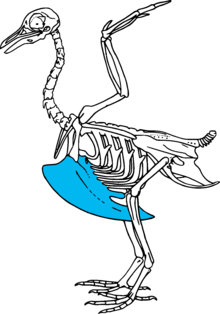Carinatae

Carinatae is the group of all
breastbone
used to anchor large flight muscles.
Classification
Definition
Traditionally, Carinatae were defined as all birds whose
pigeon family). Neither of these birds are a ratite. Thus, this supposedly distinctive feature was easy to use, but had nothing to do with actual phylogenetic relationship.[citation needed
]
Beginning in the 1980s, Carinatae was given several
apomorphy-based clade defined by the presence of a keeled sternum.[2]
The most primitive known bird relative with a keeled breastbone is Confuciusornis. While some specimens of this stem-bird have flat breastbones, some show a small ridge that could have supported a cartilaginous keel.[3]
References
- S2CID 89557960.
- ^ Gauthier, Jacques; de Queiroz, Kevin (2001). Feathered dinosaurs, flying dinosaurs, crown dinosaurs, and the name "Aves". New Perspectives on the Origin and Early Evolution of Birds: Proceedings of the International Symposium in Honor of John H. Ostrum. Peabody Museum of Natural History, Yale University. pp. 7–41.
- ^ Chiappe, Luis M.; Ji, Shu' An; Ji, Qiang; Norell, Mark A. (1999). "Anatomy and systematics of the Confuciusornithidae (Theropoda, Aves) from the late Mesozoic of northeastern China". Bulletin of the AMNH. 242.
